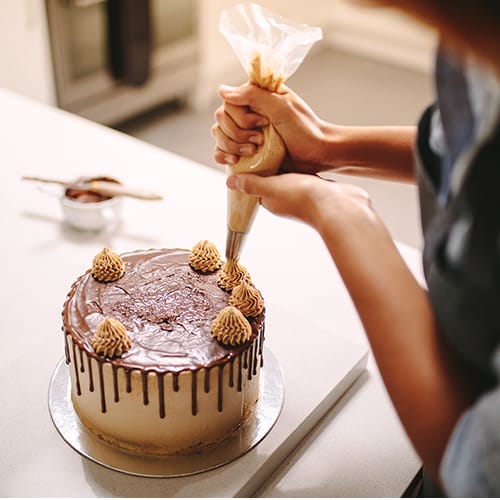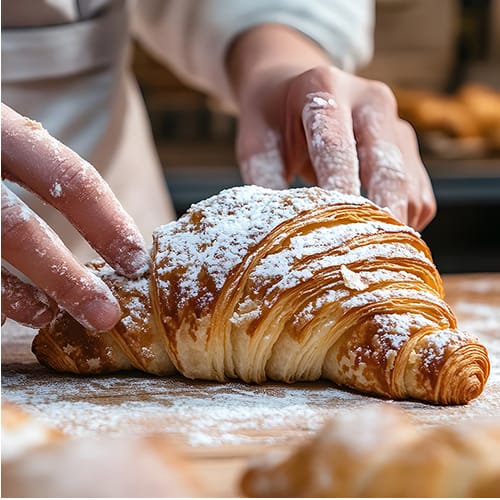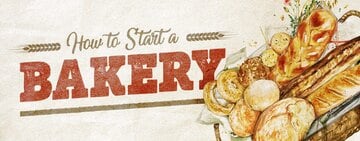
If you’re new to baking, reading recipes can feel like deciphering a foreign language. Baking is an art form that comes with a tapestry of terms, causing aspiring pastry chefs to reach for a dictionary when trying to make a loaf of bread. Whether you’re a bakery operator wanting to communicate with your staff or a culinary school student, use our alphabetized glossary of baking terms and definitions to understand the language of dough.
List of Baking Terms
Here are what our industry experts think are the 150 most important baking terms every chef should know!
A - D Baking Terms

A
- Absorption: The ability of flour to absorb water during the mixing process.
- Acetic Acid: A byproduct of fermentation that contributes to the flavor profile of bread.
- Active Dry Yeast: Yeast that is granulated and needs to be rehydrated before use.
- Active Starter: A recently fed sourdough starter that is ready for use.
- Aerate: To incorporate air into a mixture, typically by beating or whisking, to create a light and fluffy texture.
- Airbrushing: A technique using an airbrush tool to apply a fine mist of color or edible paint onto cakes for a smooth and even finish.
- Alveoli: Alveoli are the air pockets in bread caused by fermentation and gluten development.
- Amylase: An enzyme that breaks down starches into sugars during fermentation.
- Ash Content: Ash content refers to the mineral content of flour, which can affect the flavor and color of bread.
- Autolyse: A resting period during mixing that allows flour and water to hydrate.
B
- Baking Powder: A leavening agent commonly used in baking to help baked goods rise, baking powder typically contains a combination of baking soda, cream of tartar, and a moisture-absorbing agent, which react to create carbon dioxide gas when mixed with liquid ingredients.
- Baking Soda: Baking soda, also known as sodium bicarbonate, is a leavening agent used in baking that reacts with acidic ingredients such as buttermilk or vinegar to produce carbon dioxide gas, which helps baked goods rise.
- Bain-Marie: A method of gently cooking or keeping food warm by placing a food container in a larger pan of hot water.
- Baker's Math: The method bakers use to calculate ingredients based on the total flour weight.
- Baker's Percentage: The ratio of each ingredient to the total flour weight in a recipe.
- Banneton: A proofing basket that shapes bread dough.
- Basketweave: A decorative piping technique that mimics the look of woven baskets on the surface of a cake.
- Bassinage: Bassinage is the process of gradually adding water to dough during mixing.
- Batter: A batter is a liquid mixture of ingredients used to make cakes, muffins, and cake donuts.
- Bench Flour: Flour used to prevent dough from sticking to the work surface.
- Bench Rest: Allowing dough to rest on the work surface before shaping.
- Bench Scraper: A tool bakers use to divide and shape dough on the work surface.
- Blind Baking: Pre-baking a pie or tart crust with pie weights before adding the filling to ensure it is fully cooked and crisp.
- Bloom: The process of softening gelatin in a liquid before adding it to a recipe to ensure proper setting.
- Boule: A round loaf of bread with a tight crumb and crust.
- Bread Machine Yeast: Yeast specifically formulated for use in bread machines.
- Bulk Fermentation: Allowing dough to ferment in a bulk container before shaping.
- Buttercream: A creamy type of frosting made from butter, powdered sugar, and flavorings such as vanilla or cocoa, commonly used to decorate cakes.
C
- Cake Border: A decorative edge or trim that is applied to the perimeter of a cake.
- Cake Flour: A finely milled type of flour with a lower protein content than all-purpose flour, resulting in a lighter and more tender cake crumb.
- Cake Layers: Individual cake rounds of the same size stacked on each other with filling in between to create a layered cake.
- Cake Tiers: Separate layers of cake stacked on top of each other in decreasing sizes to create a multi-tiered cake.
- Carry Over Cooking: Carry over cooking refers to the phenomenon where food continues to cook and increase in temperature even after being removed from a heat source.
- Chiffon Cake: A light and airy type of cake made with oil, eggs, sugar, flour, and baking powder, resulting in a moist and tender crumb.
- Cold Proof: Proofing dough in a cold environment to slow down fermentation.
- Commercial Baker's Yeast: Yeast used in large-scale bakery operations.
- Couche: A linen cloth used to support and shape proofing bread dough.
- Cornelli: A delicate lace-like piping design commonly used to create intricate cake patterns.
- Cream: To mix ingredients, typically sugar and fat, together until smooth and creamy.
- Crimping: A decorative technique used to seal the edges of a pie or tart crust by pinching or folding the edges of the dough, creating a decorative pattern and containing the filling.
- Crumb: The tender interior of a cake formed when the batter is mixed and baked, creating a soft and fluffy texture. For bread, it refers to its interior texture, including the size and distribution of air pockets.
- Crumb Coat: Crumb coat is a thin layer of frosting that seals in crumbs and creates a smooth base before applying the final frosting layer.
D
- Damask: A pattern resembling elaborate, symmetrical designs often seen on fabric, used as a decorative motif on cakes.
- Deck Oven: A deck oven is a type of commercial oven that features multiple shelves or "decks" on which baking pans or trays can be placed, making it ideal for high-volume baking operations.
- Desired Dough Temperature (DDT): The ideal temperature for dough during mixing and fermentation.
- Desired Dough Weight (DDW): The target weight of dough for a specific recipe.
- Diastatic Malt: Malted barley flour that enhances fermentation and browning.
- Direct Method: Mixing all ingredients at once, both dry and wet, in a single bowl.
- Discard: Removing a portion of sourdough starter before feeding.
- Diving Arm Mixer: A diving arm mixer is a type of mixer with a rotating arm for kneading dough.
- Docking: Docking is pricking small holes in pastry dough, allowing steam to escape during baking and preventing the dough from puffing up too much.
- Dough Conditioner: Additives that improve dough handling and texture.
- Dowels: Wooden or plastic rods inserted into tiered cakes to prevent the layers from collapsing.
Back to Top
E - I Baking Terms

E
- Edible Yield: Edible yield refers to the portion of a food item that is usable and consumable after processing or preparation. In baking, understanding the edible yield of ingredients helps bakers accurately calculate recipe costs and portion sizes.
- Emulsion: Two liquids dispersed in each other that don't naturally mix.
- Enriched Doughs: Doughs that contain added enriching ingredients other than the standard yeast, water and flour mixture such as fats, sugars, eggs, etc.
- Enrobing: A technique used in baking and confectionery to coat food items, such as cakes, cookies, or candies, with a layer of chocolate, icing, or glaze. This process adds flavor, texture, and visual appeal to the finished product.
F
- Fermentation: The process of yeast and bacteria converting sugars into carbon dioxide and alcohol.
- Final Proof: The last stage of fermentation before baking.
- Firm Peaks: A stage in whipping egg whites or cream where the mixture holds shape when the whisk is lifted, but the tip bends slightly.
- Fluting: Fluting is a decorative technique used to create a scalloped edge on a pie or tart crust by pinching or pressing the dough between the fingers, creating a fluted pattern around the edge of the pastry.
- Fondant: A smooth, pliable icing made from sugar, water, and gelatin commonly used to cover cakes for a sleek and polished finish.
- Fork Mixer: A dough mixer with rotating tines for mixing dough.
- Frangipane: Frangipane is a sweet almond filling used in pastries like tarts and croissants. This filling is made with ground almonds, sugar, butter, and eggs, resulting in a rich and nutty flavor.
- Fresh Yeast: Live yeast used in baking that requires refrigeration.
G
- Ganache: A rich mixture of chocolate and cream used as a frosting, filling, or glaze for cakes.
- Ghee: Ghee is a type of clarified butter commonly used in Indian and Middle Eastern cooking made by simmering butter to separate the milk solids from the fat, resulting in a rich, nutty flavor and high smoke point, making it ideal for sauteing and frying.
- Gelatinize: The process of starches absorbing water and swelling during baking.
- Gluten: Gluten is a protein found in wheat flour that develops when flour is mixed with water, giving dough its stretchy texture. Gluten development is crucial in achieving the proper rise and crumb structure in baked goods.
- Gold Leaf: Thin sheets of edible gold cake decorators use to add a touch of luxury and elegance to cakes.
- Grease: To coat a pan or baking dish with a thin layer of oil or butter to prevent sticking.
- Gum Paste: A pliable sugar dough that is often used to create intricate decorations such as flowers, figurines, and other embellishments for cakes.
H
- Hand-Painted: A technique where edible colors are painted directly onto cakes for intricate designs and custom artwork.
- High Altitude Baking: High altitude baking refers to the process of adjusting recipes and baking techniques to account for the lower air pressure and higher elevation typically found at higher altitudes, ensuring baked goods rise properly and cook evenly.
- High Hydration Dough: Bread dough with a high-water content, resulting in a more open crumb structure and chewy texture in the finished loaf.
- Hooch: The liquid that forms on the surface of sourdough starter, indicating that it must be fed.
- Houndstooth: A two-tone textile pattern of broken checks, often replicated as a cake decoration for a classic and sophisticated look.
I
- Icing: Typically made with powdered sugar, butter, and flavor extracts, icing can be spread, drizzled, or piped onto cakes, cookies, and pastries to add flavor and decoration.
- Icing Comb: An icing comb is a tool with ridged edges that creates textured patterns in frosting or icing on cakes and other baked goods.
- Impression Mat: An impression mat is a textured tool used to create decorative patterns or designs on fondant, gum paste, or other pliable cake decorations.
- Instant Yeast: A type of yeast that does not require proofing and can be added directly to the dry ingredients in a recipe.
- Isomalt: Isomalt is a sugar substitute used in baking and confectionery that has a lower glycemic index and is heat-resistant, making it ideal for creating sugar decorations and pulled sugar art.
Back to Top
J - Q Baking Terms

J
- Jelly Glaze: A shiny, sweet glaze made from fruit juice, gelatin, and sugar that adds a glossy finish to baked goods and helps seal moisture for a fresh appearance.
- Jelly Roll Pan: A shallow type of baking pan with raised edges that prevents batters and liquids from spilling over the sides during baking, making it ideal for creating thin, even layers of baked goods.
- Jimmies: Also known as sprinkles, jimmies are small, rod-shaped confectionery decorations that add color and texture to baked goods.
K
- Kataifi: Kataifi is a type of shredded phyllo dough used in Middle Eastern and Mediterranean cuisines to create delicate, crispy pastries and desserts. It is often wrapped around fillings or shaped into nests before baking, or added as a crunchy ingredient in Dubai chocolate bars.
- Kitchen Scale: Kitchen scales are tools used to accurately measure ingredients by weight.
- Knead: Kneading is working and stretching bread dough to develop gluten and create the desired texture in the finished bread.
- Knock (as in knocking dough): To "knock" dough refers to the process of gently punching down risen dough to release excess gas and redistribute yeast and gluten, ensuring a uniform crumb structure and proper rise during baking.
- Kosher: A kosher food certification shows that products adhere to Jewish dietary laws and regulations. These laws dictate which foods are permissible and how they must be prepared and consumed, ensuring that the food meets specific religious standards.
L
- Lactic Acid Leaven or Leavener: A type of sourdough starter that relies on lactic acid bacteria for fermentation, resulting in a tangy flavor profile.
- Laminate: The process of layering butter between sheets of dough and folding it to create flaky, buttery pastries such as croissants.
- Lattice: A lattice crust is a decorative pie crust design made by weaving strips of dough over the top of the pie filling, adding visual appeal to the pie and allowing steam to escape during baking.
- Levain: Levain is a pre-ferment made from mixed flour and water. It develops flavor and improves the rise of bread dough.
M
- Macerate: To soak fruit in a liquid, typically alcohol or sugar, to enhance flavor and soften the fruit.
- Maillard Reaction: The Maillard reaction is a chemical reaction between amino acids and reducing sugars that occurs during baking, resulting in the browning and flavor development of bread crust.
- Maltose: A type of sugar formed during the enzymatic breakdown of starch in flour, which provides food for yeast during fermentation.
- Marble: A technique where two different colored batters are swirled together to create a marbled appearance in baked goods.
- Marzipan: Cake decorators use this sweet almond paste to create flower, fruit, or figure embellishments.
N
- Nappe: Nappe is a French culinary term that refers to the consistency of a sauce when it can coat the back of a spoon. In baking, achieving the right nappe consistency is crucial for sauces, custards, and creams.
- Nougat: Nougat is a confection made from sugar, honey, nuts, and egg whites. In baking, nougat is often used as a filling or topping for pastries, cakes, and candies.
- Nutmeg: Nutmeg is a warm, aromatic spice commonly used in baking to add depth of flavor to sweet and savory dishes.
O
- Oxidation of Dough and Flour: Refers to the exposure of dough or flour to oxygen, causing undesirable changes in flavor, color, and texture.
- Oxidizers: Ingredients such as ascorbic acid or potassium bromate that help strengthen dough and improve its volume and texture.
P
- Par-Baking: Also known as partial baking, par-baking involves baking a pie crust partially before adding the filling. It is used for pies with fillings that require different baking times than the crust or to ensure a fully cooked bottom crust.
- Pate Brisee: A type of pastry dough typically made with flour, butter, water, and salt that has a crumbly texture when baked, that complements savory pies and quiches.
- Patent Flour: A type of refined white flour with a high protein content, ideal for making bread with a strong structure and good volume.
- Pate Sucre: A sweet pastry dough that contains sugar, butter, flour, and sometimes eggs, resulting in a tender and slightly sweet crust which complements desserts like tarts and fruit pies.
- Petal Dust: Petal dust is a finely ground, edible powder that cake decorators use to add color and shading to sugar flowers and other cake embellishments.
- Phyllo Dough: Commonly used in Mediterranean and Middle Eastern cuisines, phyllo dough is a thin and delicate pastry dough made by rolling out paper-thin sheets of dough and layering them with butter or oil to create a flaky texture.
- Piping: Piping is the technique of using a piping bag and various piping tips to apply frosting, icing, or other decorative elements onto a cake.
- Proofing: Proofing is bread dough's final rise before baking, allowing the yeast to ferment and the dough to develop flavor and structure.
- Puff Pastry: A light and flaky pastry dough made by layering butter between thin sheets of dough. When baked, the butter creates steam, causing the layers to puff up and create a delicate, crispy texture.
- Pulled Sugar: A technique where sugar is heated and stretched to create delicate, intricate cake decorations.
Q
- Quenelle: A quenelle is a classic French culinary technique that shapes soft foods such as ice cream, mousse, or whipped cream into an oval or egg-like shape.
- Quick Bread: Quick breads are baked goods that leaven without yeast. They use chemical leaveners such as baking powder or baking soda to raise the dough or batter.
- Quick Mix Method: Combining both wet and dry ingredients at once.
Back to Top
R - Z Baking Terms

R
- Rapid Rise Yeast: A type of yeast specially formulated to shorten the rising time of bread dough, making it ideal for quick bread recipes.
- Rough Puff Pastry: Rough puff pastry is a simplified version of traditional puff pastry that requires less time and effort to make. It involves layering butter and dough, then folding and rolling the dough multiple times to create flaky, buttery layers in the final baked product.
- Roulade: A type of cake made by rolling a thin layer of sponge cake or genoise with a filling, often served sliced to showcase the spiral pattern.
- Royal Icing: A hard, white icing made from egg whites and powdered sugar, commonly used for intricate decorations and piping on cakes.
- Ruffles: Layers of fondant or frosting that are gathered and pleated to create a textured, ruffled effect on cakes.
S
- Sable Dough: Sable dough, pronounced SAY-bull, is a rich and crumbly pastry dough made with butter, sugar, flour, and sometimes egg yolks, resulting in a tender, buttery texture often used for making cookies and tart crusts.
- Score or Scoring: The act of slashing the surface of bread dough before baking, allowing for controlled expansion and a decorative crust pattern.
- Semolina: Semolina is a coarse durum wheat flour used in breadmaking to add texture and flavor to bread dough.
- Short Crust Pastry: A versatile pastry dough made with flour, butter, and water, resulting in a crumbly and tender crust commonly used for sweet and savory dishes.
- Shortening: Shortening is a fat used in baking to tenderize the crumb of bread and pastries, often in the form of vegetable shortening or butter.
- Sifting: The process of passing flour through a sieve to aerate it and remove any lumps, resulting in a lighter and more consistent texture in baked goods.
- Stretch and Fold: A technique used during bread dough fermentation to strengthen gluten and improve dough structure by stretching each side of the dough and then folding it over itself toward the center.
- Sugar Flowers: Intricate floral decorations made from sugar paste or gum paste to adorn cakes.
- Swiss Dots: Small, evenly spaced dots or circles piped onto cakes to create a classic and elegant design.
T
- Tare Weight: Tare weight is the weight of a container or vessel deducted from the total weight to determine the net weight of ingredients.
- Temper: To gradually raise the temperature of a mixture by adding a hot liquid to prevent curdling or seizing; bakers typically temper chocolate or eggs.
- Tube Pan: A baking pan with a hollow tube in the center, designed to promote even baking and heat distribution in cakes like angel food and chiffon cakes.
U
- Ube: A purple yam commonly used in Filipino cuisine, ube is used in baking to add a unique flavor and vibrant, natural color to desserts.
- Unsweetened Chocolate: Unsweetened chocolate, also known as baking chocolate, is pure chocolate liquor made from cocoa beans. It contains no added sugar and is commonly used in baking to add a rich, intense chocolate flavor to recipes.
V
- Vents: Small slits or holes cut into the top crust of a pie to allow steam to escape during baking, preventing the filling from bubbling over and ensuring the crust remains crisp and flaky.
- Vital Wheat Gluten: A concentrated form of gluten protein added to bread dough to improve its elasticity and rise, particularly in low-protein flours.
- Vol-au-Vent: A puff pastry shell that is typically filled with savory ingredients like chicken, seafood, or vegetables and is known for its light and flaky texture.
W
- Whip: Whipping ingredients means beating them rapidly, incorporating air, and increasing volume. It is commonly used in recipes for whipped cream, meringues, and frostings to achieve a light and airy texture.
- Whisk: A whisk is a kitchen tool used for blending, whipping, and beating ingredients together. Whisks come in various sizes and shapes, with wire loops that efficiently incorporate air into batters and mixtures.
- Work Surface: The work surface in a bakery refers to the countertop or table where baking tasks are performed.
X
- Xanthan Gum: Xanthan gum is a thickening agent and stabilizer. It helps improve the texture and shelf life of baked goods, making them more elastic and less crumbly.
- Xerophyte: A xerophyte is a plant that has adapted to survive in dry conditions, making it ideal for use in recipes that require a drier environment. Xerophytes are often used to create unique flavors and textures in bread and pastries.
- Xylanase: An enzyme commonly used in baking to break down xylan, a complex sugar found in plant cell walls, resulting in a lighter and fluffier texture in the finished product.
Y
- Yeast: A microorganism that ferments sugars in bread dough, producing carbon dioxide gas that causes the dough to rise and develop flavor.
- Yeast Nutrient: A supplement used in baking to provide essential nutrients for yeast growth and fermentation, yeast nutrient helps improve the overall performance of yeast, especially in high-sugar or low-nutrient doughs.
- Yeast Water: A natural leavening agent made by fermenting fruits or vegetables with water and sugar that can be used in place of commercial yeast to add flavor and complexity to bread and other baked goods.
Z
- 0-0 Flour: Also known as double zero flour, this finely ground flour is often used in Italian baking for making pizza dough and pasta.
- Zest: Zest refers to the outer colored portion of citrus fruit peel, which adds flavor to baked goods. Only grate the colored portion of the peel, because the white pith underneath can be bitter.
Back to Top
Now that you know essential baking terms, you can confidently navigate any bakery recipe or kitchen conversation. Take your baking skills to the next level by putting your knowledge of these terms into practice. Whether you’re baking fresh sourdough loaves or artisanal French pastries, challenge yourself with the more complex techniques described and see the difference they make in the quality of your baked goods.





